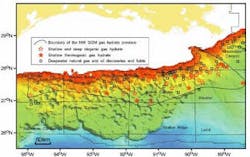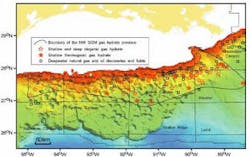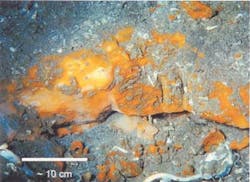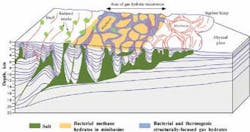GEOLOGY & GEOPHYSICS: Structurally focused gas hydrate a future northwest US Gulf resource
Natural gas hydrate is an energy mineral that occurs worldwide - onshore and offshore. The global volume of sub-marine gas hydrate resource is uncertain. Estimates vary from 0.2 x 1015 to 7,600 x 1015 m3.
There are predictions that production from submarine gas hydrate is not likely to take place before 2030 or even 2060, because of technological difficulties and economic conditions. We might wait even longer to commercialize gas hydrate if investments in gas hydrate exploration remain at the present low level.
Gas hydrate accumulations in the northwestern Gulf of Mexico are attractive from the economic standpoint. Favorable geological, technological, and economic factors are characteristic for structurally focused gas hydrate accumulations concentrated along faults and above salt ridges. Economic potential of these accumulations may be enough to initiate gas hydrate recovery. Further exploration should concentrate on specific gas hydrate accumulations to identify "sweet spots" with the highest probability of profitable exploitation.
Hydrate province
Gas hydrate localities form a belt offshore Texas and Louisiana over a distance greater than 500 km with the maximum width greater than 100 km and an areal extent of about 60,000 sq km. More than 3,000 piston cores have been taken by Geochemical and Environmental Research Group on the Gulf of Mexico continental slope. Gas hydrate was recovered at more than 53 different sites.
The minimum water depth where gas hydrate was sampled is about 440 meters and the maximum water depth is about 2,400 meters. Most gas hydrate is recovered from shallow sediments (less than 6 meters) and is observed outcropping on the seafloor. However, modeling of the gas hydrate stability zone (GHSZ) showed that gas hydrate could occur at total depths greater than 1 km in 2-3 km water depths.
Natural gas hydrates with different crystal structures are present in the northwest US Gulf. Structure I gas hydrate has a body-centered cubic lattice and contains mainly bacterial methane. Methane through isobutane might be engaged in a diamond lattice of Structure II gas hydrate. Structure H gas hydrate has a hexagonal lattice and includes methane through isopentane. Both Structure II and Structure H gas hydrates crystallize predominantly from thermogenic (oil-related) gas. The thermogenic gas hydrate is stable at higher temperature and lower pressure than bacterial gas hydrate.
Accumulation types
There are two types of gas hydrate accumulations in the northwest Gulf of Mexico. Most gas hydrate is focused along structures formed by ongoing salt deformation and active faulting. Faults serve as efficient pathways for gas migration from the deep subsurface petroleum system to the GHSZ. Prolific venting of thermogenic gas and high permeability of fractured and shallow underconsolidated sediments contribute to high gas hydrate concentrations. Gas hydrate occupies 20-30% of the sediment volume in many piston cores and intervals with up to 100% of gas hydrate were observed.
Bacterial methane hydrate in mini-basins forms the second type of accumulations. This gas hydrate was recovered, for example, by deep drilling in the Orca mini-basin. The hydrate crystallized from bacterial gas generated in situ or migrated slowly from depth. Low gas hydrate concentrations (maximum 1-2%) appear characteristic of gas hydrate accumulations in mini-basins. Low gas flux and low permeability of sediments are the main reasons for the low concentrations.
Resource estimates
Estimates of hydrate-bound gas in the northwest Gulf of Mexico gas hydrate province are based on the relationship between geologic setting, water depth, and the GHSZ. Thickness of the GHSZ was modeled based on available oceanographic (water depth, bottom water temperature) and geologic (geothermal and pressure gradients, pore water salinity, gas composition) data. The theoretical thickness of the GHSZ was corrected (usually decreased) because of the presence of shallow salt that is abundant in the area.
Structurally focused gas hydrate accumulations between mini-basins are thought to include about 8-11 x 1012 cu meters of natural gas. Gas hydrate in mini-basins contains about 2-3 x 1012 cu meters of methane. The total volume of hydrate-bound gas in the northwest Gulf of Mexico continental slope (about 10-14x1012 cu meters) is 30-40 times greater than conventional gas reserves (about 0.34 x 1012 cu meters).
Gas hydrate may be present in the Gulf of Mexico outside of the area estimated here. However, sediments in the western Gulf offshore Mexico, the eastern Gulf offshore Florida, and in the deepwater central Gulf are likely to contain only small volumes of bacterial methane hydrate. Hydrocarbon venting from mature petroleum systems is not common for these areas. Thus, their contribution to the Gulf of Mexico gas hydrate resource base is suggested to be insignificant.
Economic potential
Gas hydrate resource in mini-basins is most likely to remain sub-economic for the immediate future. Gas hydrate is too disseminated, and its concentration in sediments is too low. In contrast, structurally focused gas hydrate accumulations may provide gas hydrate reserves in the near future.
Geological, technological, and economic factors that affect economic feasibility of gas hydrate recovery seem to be favorable for exploitation of these accumulations. For example, the resource density of a gas hydrate accumulation is likely to be significant because of high gas hydrate concentration in sediments. Gas hydrate in shallow sediments with fracture porosity, filling thick veins like in an ore deposit, and high permeability should result in efficient recovery.
Development costs are predicted to be relatively low because many structurally focused gas hydrate accumulations are located at shallow water depth and near the seafloor. Nearby petroleum infrastructure - gas hydrate often occurs near oil and gas fields - would decrease the cost of transportation of hydrate-derived gas.
Gas hydrate recovery
The cost of gas hydrate production is difficult to estimate because the technology of gas hydrate recovery is not yet established. The depressurization method is not likely to be used because structurally-focused gas hydrate accumulations tend to be vertically stacked and free gas does not accumulate below them. Hydraulic mining might be too expensive and environmentally unacceptable. Thermal stimulation in combination with chemical inhibition is probably the most viable method of gas hydrate recovery in the northwest Gulf of Mexico.
Thermal stimulation involves injection of steam or hot water-inhibitor mixtures into a gas hydrate accumulation. Horizontal drilling seems to be a viable technology in gas hydrate recovery. The efficiency of thermal stimulation in the northwest Gulf needs to be carefully studied.
Concentrated gas hydrate accumulations are located at relatively shallow water depth and sub-bottom depth near equilibrium pressure-temperature conditions. Thus, relatively small volumes of steam or hot water would be needed to dissociate gas hydrate. On the other hand, the heat loss through faults and fractures may significantly decrease the efficiency of thermal stimulation.
Gas hydrate recovery implies a phase change from solid to liquid and gas. Modification of physical properties of sediment, increase of fluid content, and increase of pore pressure accompany this process and may initiate seafloor instability. Recovery technologies must be specifically designed to ensure safety during gas hydrate exploitation.
Gas hydrate resources in the northwest Gulf of Mexico are significant. Recovery of gas hydrate from concentrated structurally focused accumulations might be profitable at the present time or in the near future. However, investments in gas hydrate exploration are needed to provide more data critical for comprehensive economic analysis.
Further studies should delineate the 3D morphology of specific gas hydrate accumulations, measure gas hydrate concentration in sediments, and estimate hydrate-bound gas in place. The time to start doing our energy homework is now.
References
Bil, K., "Economic perspective of methane from hydrate," in M.D. Max (Ed.) Natural Gas Hydrate in Oceanic and Permafrost Environments. Kluwer Academic Publishers, 2000.
Crawford, T., et al, "Estimated oil and gas reserves, Gulf of Mexico, December 1997," OCS Report MMS 2000-006, U.S. Department of Interior, New Orleans, USA, 2000.
Grauls, D., "Gas hydrates: importance and applications in petroleum exploration," Marine and Petroleum Geology, v. 18, 2001.
Milkov, A., Sassen, R., "Economic geology of the Gulf of Mexico and the Blake Ridge gas hydrate provinces," Gulf Coast Association of Geological Societies Transactions, v. 51, 2001.
Sassen, R., Sweet, S., Milkov, A., DeFreitas, D., Salata, G., McDade, E., "Geology and geochemistry of gas hydrates, central Gulf of Mexico continental slope," Gulf Coast Association of Geological Societies Transactions, v. 49, 1999.



